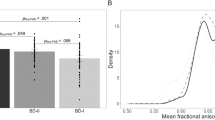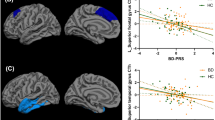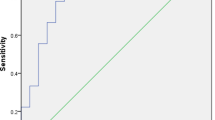Abstract
The single-nucleotide polymorphism rs9804190 in the Ankyrin G (ANK3) gene has been reported in genome-wide association studies to be associated with bipolar disorder (BD). However, the neural system effects of rs9804190 in BD are not known. We investigated associations between rs9804190 and gray and white matter (GM and WM, respectively) structure within a frontotemporal neural system implicated in BD. A total of 187 adolescent and adult European Americans were studied: a group homozygous for the C allele (52 individuals with BD and 56 controls) and a T-carrier group, carrying the high-risk T allele (38 BD and 41 controls). Subjects participated in high-resolution structural magnetic resonance imaging and diffusion tensor imaging (DTI) scanning. Frontotemporal region of interest (ROI) and whole-brain exploratory analyses were conducted. DTI ROI-based analysis revealed a significant diagnosis by genotype interaction within the uncinate fasciculus (P⩽0.05), with BD subjects carrying the T (risk) allele showing decreased fractional anisotropy compared with other subgroups, independent of age. Genotype effects were not observed in frontotemporal GM volume. These findings support effects of rs9804190 on frontotemporal WM in adolescents and adults with BD and suggest a mechanism contributing to WM pathology in BD.
This is a preview of subscription content, access via your institution
Access options
Subscribe to this journal
Receive 12 print issues and online access
$259.00 per year
only $21.58 per issue
Buy this article
- Purchase on Springer Link
- Instant access to full article PDF
Prices may be subject to local taxes which are calculated during checkout


Similar content being viewed by others
References
Blond BN, Fredericks CA, Blumberg HP . Functional neuroanatomy of bipolar disorder: structure, function, and connectivity in an amygdala-anterior paralimbic neural system. Bipolar Disord 2012; 14: 340–355.
Strakowski SM, Adler CM, Almeida J, Altshuler LL, Blumberg HP, Chang KD et al. The functional neuroanatomy of bipolar disorder: a consensus model. Bipolar Disord 2012; 14: 313–325.
Kalmar JH, Wang F, Chepenik LG, Womer FY, Jones MM, Pittman B et al. Relation between amygdala structure and function in adolescents with bipolar disorder. J Am Acad Child Adolesc Psychiatry 2009; 48: 636–642.
Chang K, Karchemskiy A, Barnea-Goraly N, Garrett A, Simeonova DI, Reiss A . Reduced amygdalar gray matter volume in familial pediatric bipolar disorder. J Am Acad Child Adolesc Psychiatry 2005; 44: 565–573.
Wang F, Kalmar JH, Womer FY, Edmiston EE, Chepenik LG, Chen R et al. Olfactocentric paralimbic cortex morphology in adolescents with bipolar disorder. Brain 2011; 134 (Pt 7): 2005–2012.
Singh MK, Chang KD, Chen MC, Kelley RG, Garrett A, Mitsunaga MM et al. Volumetric reductions in the subgenual anterior cingulate cortex in adolescents with bipolar I disorder. Bipolar Disord 2012; 14: 585–596.
Mwangi B, Spiker D, Zunta-Soares GB, Soares JC . Prediction of pediatric bipolar disorder using neuroanatomical signatures of the amygdala. Bipolar Disord 2014; 16: 713–721.
Wang F, Bobrow L, Liu J, Spencer L, Blumberg HP . Corticolimbic functional connectivity in adolescents with bipolar disorder. PLoS One 2012; 7: e50177.
Wang F, Kalmar JH, He Y, Jackowski M, Chepenik LG, Edmiston EE et al. Functional and structural connectivity between the perigenual anterior cingulate and amygdala in bipolar disorder. Biol Psychiatry 2009; 66: 516–521.
Lin F, Weng S, Xie B, Wu G, Lei H . Abnormal frontal cortex white matter connections in bipolar disorder: a DTI tractography study. J Affect Disord 2011; 131: 299–306.
McIntosh AM, Munoz Maniega S, Lymer GK, McKirdy J, Hall J, Sussmann JE et al. White matter tractography in bipolar disorder and schizophrenia. Biol Psychiatry 2008; 64: 1088–1092.
Sussmann JE, Lymer GK, McKirdy J, Moorhead TW, Munoz Maniega S, Job D et al. White matter abnormalities in bipolar disorder and schizophrenia detected using diffusion tensor magnetic resonance imaging. Bipolar Disord 2009; 11: 11–18.
Linke J, King AV, Poupon C, Hennerici MG, Gass A, Wessa M . Impaired anatomical connectivity and related executive functions: differentiating vulnerability and disease marker in bipolar disorder. Biol Psychiatry 2013; 74: 908–916.
Thiebaut de Schotten M, Dell'Acqua F, Valabregue R, Catani M . Monkey to human comparative anatomy of the frontal lobe association tracts. Cortex 2012; 48: 82–96.
McIntosh AM, Job DE, Moorhead TW, Harrison LK, Lawrie SM, Johnstone EC . White matter density in patients with schizophrenia, bipolar disorder and their unaffected relatives. Biol Psychiatry 2005; 58: 254–257.
Lu LH, Zhou XJ, Fitzgerald J, Keedy SK, Reilly JL, Passarotti AM et al. Microstructural abnormalities of white matter differentiate pediatric and adult-onset bipolar disorder. Bipolar Disord 2012; 14: 597–606.
Wang F, Kalmar JH, Edmiston E, Chepenik LG, Bhagwagar Z, Spencer L et al. Abnormal corpus callosum integrity in bipolar disorder: a diffusion tensor imaging study. Biol Psychiatry 2008; 64: 730–733.
Li J, Kale Edmiston E, Chen K, Tang Y, Ouyang X, Jiang Y et al. A comparative diffusion tensor imaging study of corpus callosum subregion integrity in bipolar disorder and schizophrenia. Psychiatry Res 2014; 221: 58–62.
Barysheva M, Jahanshad N, Foland-Ross L, Altshuler LL, Thompson PM . White matter microstructural abnormalities in bipolar disorder: a whole brain diffusion tensor imaging study. Neuroimage Clin 2013; 2: 558–568.
Wang F, Jackowski M, Kalmar JH, Chepenik LG, Tie K, Qiu M et al. Abnormal anterior cingulum integrity in bipolar disorder determined through diffusion tensor imaging. Br J Psychiatry 2008; 193: 126–129.
Emsell L, Chaddock C, Forde N, Van Hecke W, Barker GJ, Leemans A et al. White matter microstructural abnormalities in families multiply affected with bipolar I disorder: a diffusion tensor tractography study. Psychol Med 2014; 44: 2139–2150.
Wise T, Radua J, Nortje G, Cleare AJ, Young AH, Arnone D . Voxel-based meta-analytical evidence of structural disconnectivity in major depression and bipolar disorder. Biol Psychiatry 2015; 79: 293–302.
Sarrazin S, Poupon C, Linke J, Wessa M, Phillips M, Delavest M et al. A multicenter tractography study of deep white matter tracts in bipolar I disorder: psychotic features and interhemispheric disconnectivity. JAMA Psychiatry 2014; 71: 388–396.
Versace A, Almeida JR, Hassel S, Walsh ND, Novelli M, Klein CR et al. Elevated left and reduced right orbitomedial prefrontal fractional anisotropy in adults with bipolar disorder revealed by tract-based spatial statistics. Arch Gen Psychiatry 2008; 65: 1041–1052.
Houenou J, Wessa M, Douaud G, Leboyer M, Chanraud S, Perrin M et al. Increased white matter connectivity in euthymic bipolar patients: diffusion tensor tractography between the subgenual cingulate and the amygdalo-hippocampal complex. Mol Psychiatry 2007; 12: 1001–1010.
Sprooten E, Sussmann JE, Clugston A, Peel A, McKirdy J, Moorhead TW et al. White matter integrity in individuals at high genetic risk of bipolar disorder. Biol Psychiatry 2011; 70: 350–356.
Schulze TG, Detera-Wadleigh SD, Akula N, Gupta A, Kassem L, Steele J et al. Two variants in Ankyrin 3 (ANK3) are independent genetic risk factors for bipolar disorder. Mol Psychiatry 2009; 14: 487–491.
Tesli M, Koefoed P, Athanasiu L, Mattingsdal M, Gustafsson O, Agartz I et al. Association analysis of ANK3 gene variants in nordic bipolar disorder and schizophrenia case-control samples. Am J Med Genet B Neuropsychiatr Genet 2011; 156b: 969–974.
Baum AE, Akula N, Cabanero M, Cardona I, Corona W, Klemens B et al. A genome-wide association study implicates diacylglycerol kinase eta (DGKH) and several other genes in the etiology of bipolar disorder. Mol Psychiatry 2008; 13: 197–207.
Muhleisen TW, Leber M, Schulze TG, Strohmaier J, Degenhardt F, Treutlein J et al. Genome-wide association study reveals two new risk loci for bipolar disorder. Nat Commun 2014; 5: 3339.
Scott LJ, Muglia P, Kong XQ, Guan W, Flickinger M, Upmanyu R et al. Genome-wide association and meta-analysis of bipolar disorder in individuals of European ancestry. Proc Natl Acad Sci USA 2009; 106: 7501–7506.
Ferreira MA, O'Donovan MC, Meng YA, Jones IR, Ruderfer DM, Jones L et al. Collaborative genome-wide association analysis supports a role for ANK3 and CACNA1C in bipolar disorder. Nat Genet 2008; 40: 1056–1058.
Leussis MP, Madison JM, Petryshen TL . Ankyrin 3: genetic association with bipolar disorder and relevance to disease pathophysiology. Biol Mood Anxiety Disord 2012; 2: 18.
Kordeli E, Lambert S, Bennett V . AnkyrinG. A new ankyrin gene with neural-specific isoforms localized at the axonal initial segment and node of Ranvier. J Biol Chem 1995; 270: 2352–2359.
Komada M, Soriano P . [Beta]IV-spectrin regulates sodium channel clustering through ankyrin-G at axon initial segments and nodes of Ranvier. J Cell Biol 2002; 156: 337–348.
Hedstrom KL, Ogawa Y, Rasband MN . AnkyrinG is required for maintenance of the axon initial segment and neuronal polarity. J Cell Biol 2008; 183: 635–640.
Durak O, de Anda FC, Singh KK, Leussis MP, Petryshen TL, Sklar P et al. Ankyrin-G regulates neurogenesis and Wnt signaling by altering the subcellular localization of beta-catenin. Mol Psychiatry 2015; 20: 388–397.
Ching W, Zanazzi G, Levinson SR, Salzer JL . Clustering of neuronal sodium channels requires contact with myelinating Schwann cells. J Neurocytol 1999; 28: 295–301.
Paez-Gonzalez P, Abdi K, Luciano D, Liu Y, Soriano-Navarro M, Rawlins E et al. Ank3-dependent SVZ niche assembly is required for the continued production of new neurons. Neuron 2011; 71: 61–75.
McQuillin A, Rizig M, Gurling HM . A microarray gene expression study of the molecular pharmacology of lithium carbonate on mouse brain mRNA to understand the neurobiology of mood stabilization and treatment of bipolar affective disorder. Pharmacogenet Genomics 2007; 17: 605–617.
Leussis MP, Berry-Scott EM, Saito M, Jhuang H, de Haan G, Alkan O et al. The ANK3 bipolar disorder gene regulates psychiatric-related behaviors that are modulated by lithium and stress. Biol Psychiatry 2013; 73: 683–690.
Delvecchio G, Dima D, Frangou S . The effect of ANK3 bipolar-risk polymorphisms on the working memory circuitry differs between loci and according to risk-status for bipolar disorder. Am J Med Genet B Neuropsychiatr Genet 2015; 168b: 188–196.
Tesli M, Egeland R, Sonderby IE, Haukvik UK, Bettella F, Hibar DP et al. No evidence for association between bipolar disorder risk gene variants and brain structural phenotypes. J Affect Disord 2013; 151: 291–297.
Linke J, Witt SH, King AV, Nieratschker V, Poupon C, Gass A et al. Genome-wide supported risk variant for bipolar disorder alters anatomical connectivity in the human brain. Neuroimage 2012; 59: 3288–3296.
First MB, Spitzer RL, Gibbon M, Williams JBW . Structured Clinical Interview for DSM-IV Axis I & II Disorders (Version 2.0). New York State Psychiatric Institute: New York, USA, 1995.
Kaufman J, Birmaher B, Brent D, Rao U, Flynn C, Moreci P et al. Schedule for Affective Disorders and Schizophrenia for School-Age Children-Present and Lifetime Version (K-SADS-PL): initial reliability and validity data. J Am Acad Child Adolesc Psychiatry 1997; 36: 980–988.
Basser PJ, Pierpaoli C . Microstructural and physiological features of tissues elucidated by quantitative-diffusion-tensor MRI. J Magn Reson B 1996; 111: 209–219.
Hua K, Zhang J, Wakana S, Jiang H, Li X, Reich DS et al. Tract probability maps in stereotaxic spaces: analyses of white matter anatomy and tract-specific quantification. Neuroimage 2008; 39: 336–347.
Olson IR, Heide RJ, Alm KH, Vyas G . Development of the uncinate fasciculus: implications for theory and developmental disorders. Dev Cogn Neurosci 2015; 14: 50–61.
Harsan LA, Poulet P, Guignard B, Steibel J, Parizel N, de Sousa PL et al. Brain dysmyelination and recovery assessment by noninvasive in vivo diffusion tensor magnetic resonance imaging. J Neurosci Res 2006; 83: 392–402.
Larvaron P, Boespflug-Tanguy O, Renou JP, Bonny JM . In vivo analysis of the post-natal development of normal mouse brain by DTI. NMR Biomed 2007; 20: 413–421.
Takagi T, Nakamura M, Yamada M, Hikishima K, Momoshima S, Fujiyoshi K et al. Visualization of peripheral nerve degeneration and regeneration: monitoring with diffusion tensor tractography. Neuroimage 2009; 44: 884–892.
Underwood CK, Kurniawan ND, Butler TJ, Cowin GJ, Wallace RH . Non-invasive diffusion tensor imaging detects white matter degeneration in the spinal cord of a mouse model of amyotrophic lateral sclerosis. Neuroimage 2011; 55: 455–461.
Tkachev D, Mimmack ML, Ryan MM, Wayland M, Freeman T, Jones PB et al. Oligodendrocyte dysfunction in schizophrenia and bipolar disorder. Lancet 2003; 362: 798–805.
Ongur D, Drevets WC, Price JL . Glial reduction in the subgenual prefrontal cortex in mood disorders. Proc Natl Acad Sci USA 1998; 95: 13290–13295.
Uranova NA, Vostrikov VM, Orlovskaya DD, Rachmanova VI . Oligodendroglial density in the prefrontal cortex in schizophrenia and mood disorders: a study from the Stanley Neuropathology Consortium. Schizophr Res 2004; 67: 269–275.
Vostrikov VM, Uranova NA, Orlovskaya DD . Deficit of perineuronal oligodendrocytes in the prefrontal cortex in schizophrenia and mood disorders. Schizophr Res 2007; 94: 273–280.
Wirgenes KV, Tesli M, Inderhaug E, Athanasiu L, Agartz I, Melle I et al. ANK3 gene expression in bipolar disorder and schizophrenia. Br J Psychiatry 2014; 205: 244–245.
Yuan A, Yi Z, Wang Q, Sun J, Li Z, Du Y et al. ANK3 as a risk gene for schizophrenia: new data in Han Chinese and meta analysis. Am J Med Genet B Neuropsychiatr Genet 2012; 159b: 997–1005.
Nie F, Wang X, Zhao P, Yang H, Zhu W, Zhao Y et al. Genetic analysis of SNPs in CACNA1C and ANK3 gene with schizophrenia: a comprehensive meta-analysis. Am J Med Genet B Neuropsychiatr Genet 2015; 168: 637–648.
Benedetti F, Bollettini I, Barberi I, Radaelli D, Poletti S, Locatelli C et al. Lithium and GSK3-beta promoter gene variants influence white matter microstructure in bipolar disorder. Neuropsychopharmacology 2013; 38: 313–327.
Benedetti F, Bollettini I, Poletti S, Locatelli C, Lorenzi C, Pirovano A et al. White matter microstructure in bipolar disorder is influenced by the serotonin transporter gene polymorphism 5-HTTLPR. Genes Brain Behav 2015; 14: 238–250.
Poletti S, Bollettini I, Mazza E, Locatelli C, Radaelli D, Vai B et al. Cognitive performances associate with measures of white matter integrity in bipolar disorder. J Affect Disord 2015; 174: 342–352.
Logue MW, Solovieff N, Leussis MP, Wolf EJ, Melista E, Baldwin C et al. The ankyrin-3 gene is associated with posttraumatic stress disorder and externalizing comorbidity. Psychoneuroendocrinology 2013; 38: 2249–2257.
Chen XD, Xiong DH, Yang TL, Pei YF, Guo YF, Li J et al. ANKRD7 and CYTL1 are novel risk genes for alcohol drinking behavior. Chin Med J 2012; 125: 1127–1134.
Dick DM, Wang JC, Plunkett J, Aliev F, Hinrichs A, Bertelsen S et al. Family-based association analyses of alcohol dependence phenotypes across DRD2 and neighboring gene ANKK1. Alcohol Clin Exp Res 2007; 31: 1645–1653.
Gelernter J, Yu Y, Weiss R, Brady K, Panhuysen C, Yang BZ et al. Haplotype spanning TTC12 and ANKK1, flanked by the DRD2 and NCAM1 loci, is strongly associated to nicotine dependence in two distinct American populations. Hum Mol Genet 2006; 15: 3498–3507.
Yang BZ, Kranzler HR, Zhao H, Gruen JR, Luo X, Gelernter J . Association of haplotypic variants in DRD2, ANKK1, TTC12 and NCAM1 to alcohol dependence in independent case control and family samples. Hum Mol Genet 2007; 16: 2844–2853.
Yang BZ, Kranzler HR, Zhao H, Gruen JR, Luo X, Gelernter J . Haplotypic variants in DRD2, ANKK1, TTC12, and NCAM1 are associated with comorbid alcohol and drug dependence. Alcohol Clin Exp Res 2008; 32: 2117–2127.
Hajek T, Carrey N, Alda M . Neuroanatomical abnormalities as risk factors for bipolar disorder. Bipolar Disord 2005; 7: 393–403.
Mitchell AS, Sherman SM, Sommer MA, Mair RG, Vertes RP, Chudasama Y . Advances in understanding mechanisms of thalamic relays in cognition and behavior. J Neurosci 2014; 34: 15340–15346.
Foland-Ross LC, Thompson PM, Sugar CA, Narr KL, Penfold C, Vasquez RE et al. Three-dimensional mapping of hippocampal and amygdalar structure in euthymic adults with bipolar disorder not treated with lithium. Psychiatry Res 2013; 211: 195–201.
Cassidy C, Buchy L, Bodnar M, Dell'elce J, Choudhry Z, Fathalli F et al. Association of a risk allele of ANK3 with cognitive performance and cortical thickness in patients with first-episode psychosis. J Psychiatry Neurosci 2014; 39: 31–39.
Dima D, Jogia J, Collier D, Vassos E, Burdick KE, Frangou S . Independent modulation of engagement and connectivity of the facial network during affect processing by CACNA1C and ANK3 risk genes for bipolar disorder. JAMA Psychiatry 2013; 70: 1303–1311.
Fiorentino A, O'Brien NL, Locke DP, McQuillin A, Jarram A, Anjorin A et al. Analysis of ANK3 and CACNA1C variants identified in bipolar disorder whole genome sequence data. Bipolar Disord 2014; 16: 583–591.
Acknowledgements
We were supported by research grants from the National Institute of Health (NIH) R01MH69747(HPB), R01MH070902(HPB), R01DA12690(JG), R01DA12849(JG), RC1MH088366(HPB), T32MH014276(ETCL), T32DA022975(ETCL) and K01MH086621(FW); CTSA UL1TR000142 from the NIH National Center for Advancing Translational Science, US Department of Veterans Affairs Research Enhancement Award Program (to FW, HPB and JG) and Career Development Award (to KPJ); International Bipolar Foundation (to HPB); Brain and Behavior Research Foundation (to FW, and HPB); Attias Family Foundation (to HPB); Klingenstein Third Generation Foundation (to FW); Women’s Health Research at Yale (to HPB); and The John and Hope Furth Endowment (to HPB). We thank Susan Quatrano and Philip Markovich for their assistance with the research; Cheryl Lacadie, Karen Martin, Terry Hickey and Hedy Sarofin for their technical expertise; Ann Marie Lacobelle for her genotyping assistance; Dr Andrew McIntosh for his comments on an earlier version of this manuscript; and the research subjects for their participation.
Author information
Authors and Affiliations
Corresponding author
Ethics declarations
Competing interests
The authors declare no conflict of interest.
PowerPoint slides
Rights and permissions
About this article
Cite this article
Lippard, E., Jensen, K., Wang, F. et al. Effects of ANK3 variation on gray and white matter in bipolar disorder. Mol Psychiatry 22, 1345–1351 (2017). https://doi.org/10.1038/mp.2016.76
Received:
Revised:
Accepted:
Published:
Issue Date:
DOI: https://doi.org/10.1038/mp.2016.76
This article is cited by
-
Phenotypes, mechanisms and therapeutics: insights from bipolar disorder GWAS findings
Molecular Psychiatry (2022)
-
Roles and mechanisms of ankyrin-G in neuropsychiatric disorders
Experimental & Molecular Medicine (2022)
-
The genetics of bipolar disorder
Molecular Psychiatry (2020)
-
Association of LHPP genetic variation (rs35936514) with structural and functional connectivity of hippocampal-corticolimbic neural circuitry
Brain Imaging and Behavior (2020)
-
Disruption of the psychiatric risk gene Ankyrin 3 enhances microtubule dynamics through GSK3/CRMP2 signaling
Translational Psychiatry (2018)



